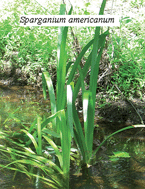The Savannah River Site was constructed in South Carolina to produce plutonium (Pu) in the 1950s. Discharges associated with these now-ceased operations have contaminated large areas within the site, particularly streams associated with reactor cooling basins. Evaluating the exposure risk of contamination to an ecosystem requires methodologies that can assess the bioavailability of contaminants. Plants, as primary producers, represent an important mode of transfer of contaminants from soils and sediments into the food chain. The objective of this study was to identify local area plants for their ability to act as bio-monitors of radionuclides. The concentrations of cesium-137 (137Cs), potassium-40 (40K), 238Pu and 239,240Pu in plants and their associated soils were determined using γ and α spectrometry. The ratio of contamination concentration found in the plant relative to the soil was calculated to assess a concentration ratio (CR). The highest CR for 137Cs was found in Pinus palustris needles (CR of 2.18). The correlation of soil and plant 137Cs concentration was strong (0.76) and the R2 (0.58) from the regression was significant (p = 0.006). This suggests the ability to predict the degree of 137Cs contamination of a soil through analysis of the pine needles. The 238Pu and 239,240Pu concentrations were most elevated within the plant roots. Extremely high CR values were found in Sparganium americanum (bur-reed) roots with a value of 5.86 for 238Pu and 5.66 for 239,240Pu. The concentration of 40K was measured as a known congener of 137C. Comparing 40K and 137C concentrations in each plant revealed an inverse relationship for these radioisotopes. Correlating 40K and 137Cs was most effective in identifying plants that have a high affinity for 137Cs uptake. The P. palustris and S. americanum proved to be particularly strong accumulators of all K congeners from the soil. Some species that were measured, warrant further investigation, are the carnivorous plant Utricularia inflata (bladderwort) and the emergent macrophyte Juncus effusus. For U. inflata, the levels of 137Cs, 238Pu, and 239,240Pu (which were 3922, 8399, and 803 Bq kg−1, respectively) in the leaves were extremely high. The highest 137Cs concentration from the study was measured in the J. effusus root (5721 Bq kg−1).


 Please wait while we load your content...
Please wait while we load your content...